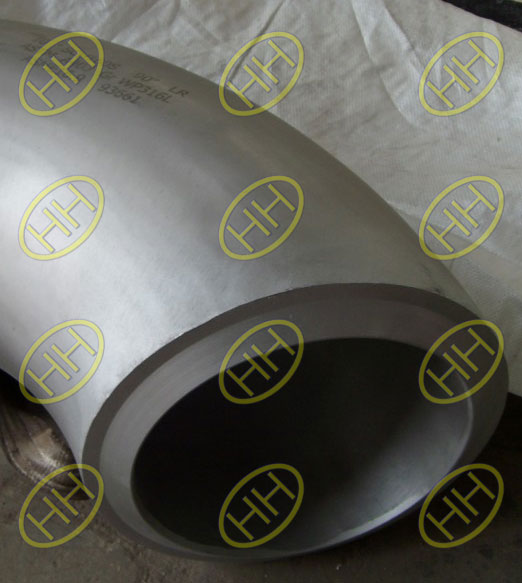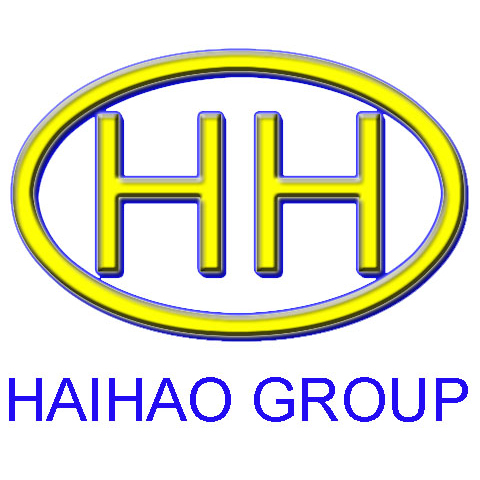Haihao Group’s ASME B16.9 90 degree elbow LR 32in ASTM A182 F316L for subsea pipeline projects
In the demanding and dynamic realm of subsea pipeline projects, every component is rigorously scrutinized for its ability to ensure the seamless, safe, and uninterrupted flow of vital resources. At Haihao Group, we take immense pride in offering our high-quality ASME B16.9 90-degree Long Radius (LR) Elbow, specifically in 32-inch diameter and crafted from ASTM A182 F316L stainless steel, as a cornerstone solution for the most challenging subsea pipeline installations. With its optimized design, superior material properties tailored for marine environments, and unwavering performance validated through stringent testing, our elbow is engineered to be a cornerstone for reliable fluid transport in these critical and harsh deep-water projects.

90D LR ASTM A403 GR WP316L ASME B16.9 Elbow With Bevel End
1. ASME B16.9 90° LR Elbow: Engineering for Subsea Hydraulic Efficiency
The design of a pipe elbow significantly impacts fluid dynamics and the overall efficiency of a pipeline system, particularly in the energy-intensive subsea environment. Our ASME B16.9 90-degree Long Radius (LR) 32-inch elbow is meticulously engineered to provide seamless directional changes, promoting optimal and efficient flow within subsea pipelines.
Long Radius Advantage (1.5D): The LR design, characterized by a bending radius equal to 1.5 times the nominal pipe diameter (1.5D), offers distinct hydraulic benefits over its short radius (1D) counterpart. This gradual bend minimizes flow resistance and pressure drop, directly translating to reduced pumping energy requirements and lower operational costs over the pipeline’s lifespan. Furthermore, the smoother flow path is critical for preventing erosion-corrosion in high-velocity lines and facilitates efficient pigging operations, ensuring pipeline cleanliness and integrity.
Precision 90-Degree Bend: The exact 90-degree angle ensures precise redirection of fluids or gases, optimizing pipeline routing and minimizing unnecessary stress points within the system.
Addressing Subsea Design Challenges: Subsea elbows must withstand not only internal pressure but also immense external hydrostatic pressure, vortex-induced vibrations (VIV) from ocean currents, and thermal expansion cycles. The robust ASME B16.9 design, combined with appropriate wall thickness, provides the structural integrity necessary to resist these multi-directional forces and fatigue.
2. Material Excellence for Subsea: ASTM A182 F316L Stainless Steel
At Haihao Group, we deeply recognize that material selection is the single most critical factor for components deployed in subsea environments, where extreme pressures, fluctuating temperatures, and aggressive corrosive elements pose significant challenges. Our ASME B16.9 90-degree LR 32-inch elbow is exclusively crafted from ASTM A182 F316L stainless steel, a material globally renowned for its exceptional corrosion resistance and durability in marine applications.
2.1 ASTM A182 F316L: Chemical Composition and Properties
F316L is a low-carbon austenitic stainless steel. Its superior performance in corrosive environments, especially seawater, is attributed to its precise chemical composition:
Chromium (Cr): Approximately 16-18% – Provides the primary corrosion resistance through the formation of a passive oxide layer.
Nickel (Ni): Approximately 10-14% – Enhances ductility, toughness, and general corrosion resistance.
Molybdenum (Mo): Approximately 2-3% – This is the key alloying element for subsea applications. Molybdenum significantly boosts resistance to pitting corrosion and crevice corrosion, common and aggressive forms of localized corrosion in chloride-rich environments like seawater.
Low Carbon (L): Max 0.03% – The “L” denotes low carbon content, which minimizes carbide precipitation during welding. This is crucial for preventing intergranular corrosion (weld decay) in the heat-affected zone (HAZ), ensuring the integrity of welded joints in highly corrosive conditions.
2.2 Why F316L is Preferred for Subsea Over Other Grades
While other stainless steels exist, F316L stands out for subsea applications due to its balanced properties:
This high-grade material ensures long-term reliability and maintains its structural integrity and leak-proof performance, even in the harshest subsea conditions involving corrosive seawater, various chemicals, and abrasive particles.
3. Ensuring Subsea Integrity: ASME B16.9 Compliance and Performance Validation
Our ASME B16.9 90-degree LR 32-inch elbow is meticulously manufactured in strict adherence to industry standards and specifications, guaranteeing the utmost precision, consistency, and performance required for critical subsea pipeline projects.
Adherence to ASME B16.9: This standard rigorously governs the dimensions, tolerances, and testing requirements for factory-made wrought butt-welding fittings. By conforming to these precise standards, we guarantee exact fit-up with corresponding pipes and other fittings, minimizing installation time and ensuring system compatibility.
Integration with Pipeline Codes: While ASME B16.9 specifies the fitting, its application within a subsea pipeline system is governed by codes such as ASME B31.4 (Liquid Transportation Systems for Hydrocarbons) or ASME B31.8 (Gas Transmission and Distribution Piping Systems). Our fittings are designed to seamlessly integrate into systems compliant with these overarching pipeline codes, ensuring full system integrity.
Controlled Manufacturing Processes: We employ advanced forming techniques (e.g., hot induction bending or seamless pipe forming) followed by precise machining and welding (if applicable) to ensure uniform wall thickness and a consistent grain structure, crucial for resisting external pressure and fatigue in subsea environments.
External Pressure Resistance: Beyond internal pressure, subsea elbows must withstand immense external hydrostatic pressure. The robust material (F316L) and controlled manufacturing ensure the fitting’s ability to resist collapse under deepwater conditions, a critical safety factor.
4. Beyond Standards: Haihao Group’s Rigorous Testing for Subsea Reliability
To provide unrivaled reliability for subsea applications, where retrieval and repair are exceptionally costly and complex, our ASME B16.9 90-degree LR 32-inch elbow undergoes an extensive series of comprehensive and rigorous testing procedures.
Material Traceability and Certification
Every elbow is backed by comprehensive Material Test Certificates (MTCs), detailing chemical composition, mechanical properties, and heat treatment records. This full traceability is essential for critical subsea components.
Non-Destructive Examinations (NDE):
Ultrasonic Testing (UT): Verifies the internal integrity of the elbow, detecting subsurface flaws, laminations, or inclusions that could compromise performance under pressure.
Radiographic Testing (RT): (X-ray or Gamma ray) Provides a visual image of the internal structure, identifying hidden flaws, porosity, or cracks in welds and the base material.
Magnetic Particle Testing (MPT) or Liquid Penetrant Testing (LPT): Used to detect surface and near-surface discontinuities or cracks.
Dimensional & Visual Inspection: Precise measurements are taken for critical dimensions (OD, wall thickness, end bevels) and a thorough visual inspection is performed to ensure surface quality and adherence to ASME B16.9 tolerances.
Hydrostatic Pressure Testing (Optional/Applicable): While not always mandatory for fittings alone, we can perform or verify hydrostatic testing at specified pressures to ensure leak-proof performance and structural integrity under operational conditions.
Corrosion Resistance Testing (Optional/Applicable): For highly specific subsea conditions, additional tests like Salt Spray Test or specific intergranular corrosion tests for F316L might be conducted to simulate the marine environment.
By subjecting our products to such stringent testing, we ensure that only the highest-quality, defect-free elbows are delivered to our clients. This unwavering commitment to excellence and meticulous attention to detail truly distinguish Haihao Group as a trusted supplier in the subsea pipeline industry.
5. Customization for Complex Subsea Project Challenges
We understand that every subsea pipeline project presents unique challenges, often requiring specific engineering solutions beyond standard specifications. At Haihao Group, we pride ourselves on offering extensive customization options for our ASME B16.9 90-degree LR 32-inch ASTM A182 F316L elbows to cater precisely to the bespoke needs of each project.
Our team of seasoned experts collaborates closely with clients from conceptualization through delivery to understand:
Specific Project Objectives: Including flow rates, pressure requirements, and design life.
Unique Environmental Conditions: Such as ultra-deepwater depths, high-corrosion zones, specific current profiles, or seismic activity.
Special Material Specifications: Beyond standard F316L, if combined with other alloys or requiring enhanced properties.
Specific Installation Constraints: Including welding techniques, handling equipment, or integration with existing infrastructure.
This collaborative engineering approach ensures that our elbows are meticulously tailored to provide precise fit, seamless integration, and optimal performance in the most demanding subsea pipeline installations. Examples of customization include specific bend radii (for non-standard LR), non-standard wall thicknesses, specialized end preparations for advanced welding techniques (e.g., orbital welding), or specific surface finishes.
6. Key Challenges in Subsea Pipeline Fittings & How F316L Addresses Them
Subsea environments pose a unique set of challenges that impact the design, material selection, and longevity of pipeline fittings. Our ASME B16.9 90° LR 32in ASTM A182 F316L elbow is specifically engineered to mitigate these risks:
External Hydrostatic Pressure: As pipelines extend into ultra-deep waters, the external pressure becomes immense. The wrought nature of F316L, combined with precise manufacturing and appropriate wall thickness based on ASME codes, provides superior collapse resistance compared to cast alternatives.
Corrosion (Chloride & MIC): Seawater is a highly corrosive, chloride-rich environment. F316L’s molybdenum content significantly enhances its resistance to pitting and crevice corrosion, the most common forms of localized attack in submerged conditions. It also exhibits good resistance to Microbiologically Influenced Corrosion (MIC), a concern in marine environments.
Fatigue (VIV/VIM): Vortex-Induced Vibrations (VIV) from ocean currents and Vortex-Induced Motion (VIM) from rig movements can induce fatigue. The inherent ductility and toughness of wrought F316L, along with the smooth, low-stress design of an LR elbow, contribute to better fatigue resistance than brittle materials or sharp-angled designs.
Thermal Expansion & Contraction: Fluctuating subsea temperatures (e.g., from hot fluids) can cause thermal expansion and contraction. The excellent ductility of F316L allows it to accommodate these stresses more effectively than rigid materials, preventing crack initiation.
Installation & Handling: Large-diameter, heavy components like 32-inch elbows require specialized handling. Our precise manufacturing ensures dimensional consistency, facilitating easier and safer welding and installation in challenging subsea conditions.
7. Installation and Maintenance Considerations for Subsea Elbows
Ensuring the long-term integrity of subsea elbows requires careful attention during installation and consideration for future maintenance.
Welding Procedures: For ASTM A182 F316L, proper welding procedures are crucial to maintain corrosion resistance. This includes using appropriate filler metals (e.g., ER316L), controlling heat input to prevent sensitization, and ensuring clean weld preparations. For large diameters, specialized welding techniques (e.g., orbital welding) may be employed for consistent, high-quality welds.
Handling and Lifting: Due to their size and weight, large-diameter subsea elbows require specialized lifting equipment and rigging to prevent damage during transportation, offshore transfer, and subsea deployment. Proper lifting points and procedures are critical.
Corrosion Protection Integration: While F316L offers excellent inherent corrosion resistance, additional protection might be required depending on the specific subsea zone (e.g., splash zone, buried), such as cathodic protection systems, specialized anti-corrosion coatings, or insulation, which must be carefully integrated with the fitting.
Long-Term Monitoring: Although designed for long service life, visual inspection during ROV (Remotely Operated Vehicle) surveys and potential NDE post-installation can contribute to long-term asset integrity management.
8.Haihao Group – Your Trusted Partner for Subsea Pipeline Excellence
Contact Haihao Group today to learn more about our ASME B16.9 90-degree LR 32-inch ASTM A182 F316L elbow, discuss your specific project requirements, and discover how our expertise can enhance the efficiency, safety, and performance of your subsea pipeline projects. Together, let us forge a path towards successful and resilient subsea infrastructure for the future.
Email: sales@haihaogroup.com

